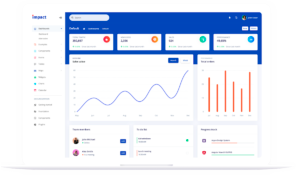Survey: working from home is creating new challenges
15 min read
On this page
The Covid-19 crisis has forced most businesses to work from home. It has pushed small businesses to adapt to an unfamiliar work environment while coping with the economic disruption. We surveyed businesses employing between 20 and 250 people about the impact of work-from-home on their business and what the future of work looks like, at least in the near future.
The results surprised us and showed a massive, long-term impact on many sections of the economy. It’s changing not just how people work but also how small businesses buy and sell. The work-from home culture is going to have wide ranging, long-term ramifications.
Read on to see how these challenges will impact your small business and how to make most of them.

Work-from-home is not the future – it’s the present
While the crisis forced most businesses into working from home, they plan to continue doing it due to its long-term benefits.
“I and many of my co-workers have found working from home to be very pleasant and can be a very productive experience, and would love to continue it after the pandemic ends.” – Tyler Brooks, JAM Paper
75% of the survey respondents said that every employee in their business is working from home. But more importantly, 33% of small businesses who responded do not plan to have an office in the future. Another 33% plan to have only essential staff work from the office in the future. This means 2 out of every 3 small businesses will either not have an office or have a smaller office in the future. Before the crisis, all of them were working either fully or partially from an office.
Once we do feel safe going back, we’ll give employees the option. If enough decide to work from home permanently, we’ll likely close the physical office. The transition to WFH was very easy for us, as everyone is well-versed in technology, so we expect a permanent move to this model would also be easy and well-received.” – Rex Freiberger, President, GadgetReview
“We will slowly be transitioning our business to be fully remote by October. This is when the lease expires for our office, and there’s really no reason to keep it open.” – Dan Bailey, President, WikiLawn
What is driving this change in the mindset of small businesses? It’s the realization that working from home brings several benefits from lower costs to higher productivity and employee engagement. These add up to a significant impact on the bottom line.
The most significant benefit of working from home is happier employees and higher productivity. Most employees are happier working from home as they avoid the stress of commuting and save on commute time. They achieve a better work-life balance. Happier employees with more time on hand are delivering higher productivity for businesses.
These are not new findings, as we have seen these benefits of remote work in the past as well. The difference is that businesses that earlier did not believe in remote work are now seeing the benefits first-hand and loving it.
“We have no plans to bring people back into the office. Our employee survey told us that most people felt more productive working from home. This has numerous benefits for us as a business. Happier staff, larger geographical areas that we can recruit from, more office capacity for growth and overall a better work life balance.” – Richard Waters, Sales Director, Salience Search Marketing
“During the lockdown, we’ve noticed our employees increased their productivity levels, and that they were able to do more while working less. Simply, there was no commuting time, and they could better manage their work and outside-of-work engagements. Furthermore, they were better rested and had fewer distractions.” – Dusan Goljic, co-founder of DealsOnHealth
What does it mean for the economy and for you?
Lower demand for office space
One obvious impact will be significantly less demand for office space by small businesses. As the current leases run out, landlords will find it hard to find new tenants. We could see more layoffs by real estate management and facilities management firms. If you’re in the industry, fasten your seatbelt for a rough ride.
“We plan to give everyone a choice of working remotely or from the office. We run a poll asking this question once per month, and so far, 90% of our employees prefer working from home, for various reasons. If things stay this way, we just may not go back to the office again, so we can save both time and money.” – Malte Scholz, CEO and Co-Founder, Airfocus.
Lower demand for office will mean reduced demand for workstations and other office fixtures. Employees setting up the home office could pick up some of that slack. But the impact on office fixture suppliers could be very real over the next few months.
Office supply purchases will become decentralized
If you sell office supplies like stationery to small businesses, be prepared to change your business model. Your customers may want you to deliver the supplies directly to their employees’ homes rather than to their offices. This would mean more complexity and higher delivery costs.
some respondents said they plan to give employees a monthly allowance for the home office setup. That could lead to employees ordering supplies like pens and notepads themselves from wherever they find more convenient. It can disrupt many small office supply businesses that relied on monthly orders from clients. If you’re one of those, start thinking about diversifying your marketing to attract employees working from home.
Data consumption shift from office to home office
Telecom and internet service providers are another group that needs to adapt to the shift to working from home. As the work shifts from office to home, the data consumption will also move from office to home. Employees working from home will need more bandwidth and higher data plans.
While in the past most homes had one internet provider, they now need a backup provider in case the primary network goes down. If you sell internet and other office telecom services, start marketing to employees working from home. If you can’t be the primary, at least become the backup internet provider.
Demand for tools to manage employees working from home
Another interesting impact of work-from-home is the need to have a different set of processes and approaches to managing employees. Managers can no longer walk up to employees to check on their work. This is forcing businesses to adopt more objective and goal-driven employee assessment processes. It has created an enormous demand for tools to manage remote employees.
“Many of our managers struggled transitioning to WFH. We found that many of our managers worked best with others and provided feedback in the office environment. They weren’t able to do this when going remote. We worked with our management team to focus on goal-oriented metrics, which has given them new insight on who is really a productive contributor.” – Neal Taparia, Solitaired.
While most businesses had a time & attendance system in the office, those systems don’t work when people are working from home. Tracking time is important for many service businesses because they bill their clients or pay employees by the hour. Even if you don’t need to bill or pay by the hour, tracking time people spend on work is still important for multiple reasons. At HiveDesk, we’ve seen a surge in demand for our time tracking software.
You may need it for payroll processing and keeping track of leaves. In Europe, labor laws require businesses to track employees’ time to ensure they are not overworked. It can also help you see if some employees are working longer hours but not being as productive as others. These employees may need training or help to make them more productive and to prevent them from burning out.
One of the biggest challenges respondents faced is ensuring effective communication and collaboration with the distributed team. As a result, small businesses are now using more communication and collaboration tools than ever before. Slack and Zoom are the most popular communication tools used by small businesses, with almost 33% of them using one or both. Over 20% of small businesses say they have started using online project management tools like Asana to improve collaboration between team members.
“The primary challenge was setting up a system that would facilitate effective communication and collaboration with a distributed team. Luckily, we were already using Asana. We added a video conferencing tool to facilitate face-to-face meetings.” – Reuben Yonatan, Founder and CEO, GetVoIP.
Many businesses have created a virtual water cooler on Slack or other chat tools to encourage informal interactions. The Donut extension for Slack is one of the most popular ways to recreate the office water cooler.
“What’s changed is that we have refined the way we use our systems and tools. We’ve added the Donut extension to facilitate meet-ups for coffee or lunch breaks, regular contact between employees.” – Alex Azoury, Founder & CEO, Home Grounds
“Managers have to create a virtual chill-out room where colleagues can share and bond, praise team members’ achievements publicly, and help facilitate the team working together without delving into deadly micromanagement.” – Brett Downes, Founder, Haro Helpers Inc.
“It is more of the social aspect we miss, but we have found that our virtual meetings are much more productive. We’ve been using tools like Slack, Zoom, and Google Sheets so all stay on the same page and have enjoyed this way of working much more! We plan to stick to it.” – Kimberly Porter, CEO, Microcredit Summit.
How does this new found demand for software tools affect your business?
There is a clear shift towards cloud-hosted software. These are easier to access for employees and simpler to administer by the IT team. If you’re a desktop software provider that sells to small businesses, consider developing a SaaS or cloud version.
Impact of work-from-home on training & development businesses
Employee training and development is an integral part of a successful business. This includes both technical training and soft skills & culture-building programs. Businesses providing training and development services need to reinvent their business models. They need to develop online versions of their training programs.
While it’s easier to create an online technical training program for software development or marketing, it’s a challenge to adapt soft skills training. How do you conduct team building programs that require employees to work together and interact in real-time? How do you monitor and provide feedback to employees while maintaining privacy? These are some of the important questions training and development companies must address to adapt to the work-from-home model.
Impact of work-from-home on IT support and help desk providers
IT support and help desk is even more important now. Employees can’t ask co-workers for a quick help. IT support team will need to log in remotely to make changes to the computer and fix problems instead of walking up to employees’ desks and fixing the problem.
The standard method of deploying software updates and patches over a secure LAN will no longer work. IT will need to find ways to efficiently do that for each employee’s computer individually. About 20% of respondents identified providing standardized IT equipment and support as an immediate challenge. This number will only increase in the future as businesses roll out upgrades to equipment and software.
IT departments at small businesses are responding to challenges posed by work-from-home by replacing desktop applications with cloud-based SaaS and allowing employees to use their own computers.
SaaS applications are simpler to administer as the IT team does not need to roll out patches and upgrades to every employee. The software provider takes care of that since employees access applications on vendor’s servers. Data security is less of a challenge as SaaS applications store data directly on the servers.
Allowing employees to use their own computer for work is becoming popular. Since most employees don’t have administrative access to their work computers, they need help from the IT team for even minor issues. By allowing them to use their own computers, IT will have a lot fewer things to worry about.
A major worry for IT support teams is to secure the computer and data during transmission. Since employees could be using various internet service providers with differing levels of security, it’s a challenge for the IT teams to secure data and access to servers. More small businesses are deploying VPN to safeguard their employees’ computers and data.
“We have also been using tools like VPNs and VPS to ensure maximum security while connecting to our work servers from home. Employees’ home systems may not be secure and since the company data is critical and confidential, allowing them to work from home has its risks. A VPN takes care of that problem.” – Abdul Rehman, VPNRanks
If you provide IT support and helpdesk services to small businesses, you need to create new processes to remotely support your customers’ employees. You also need to offer them new tools like VPN. You may have to come up with a new pricing plan to support visits to employees’ homes instead of a single office location.
Most small businesses are deciding to give up an office completely or partially as they realize the benefits of working from home. If you serve small businesses, you need to reinvent your business model to stay relevant, continue to add value to your customers, and remain profitable. How you adapt to these changes in the next couple of months will determine whether you continue to prosper.

